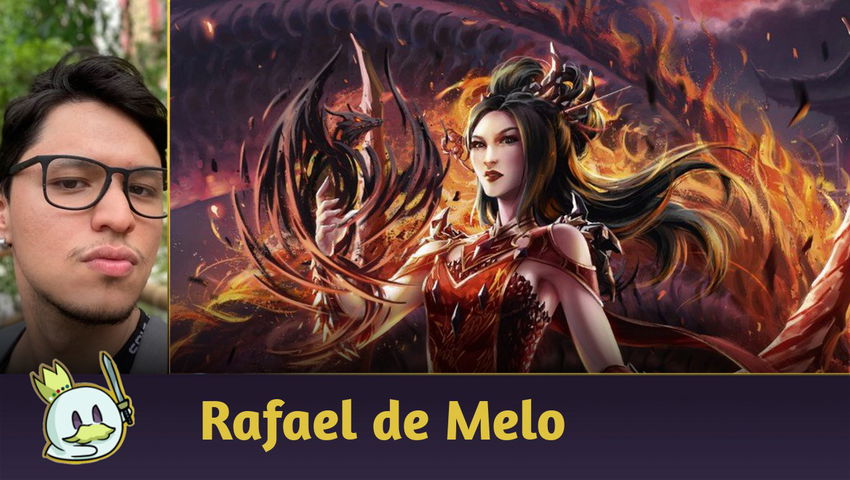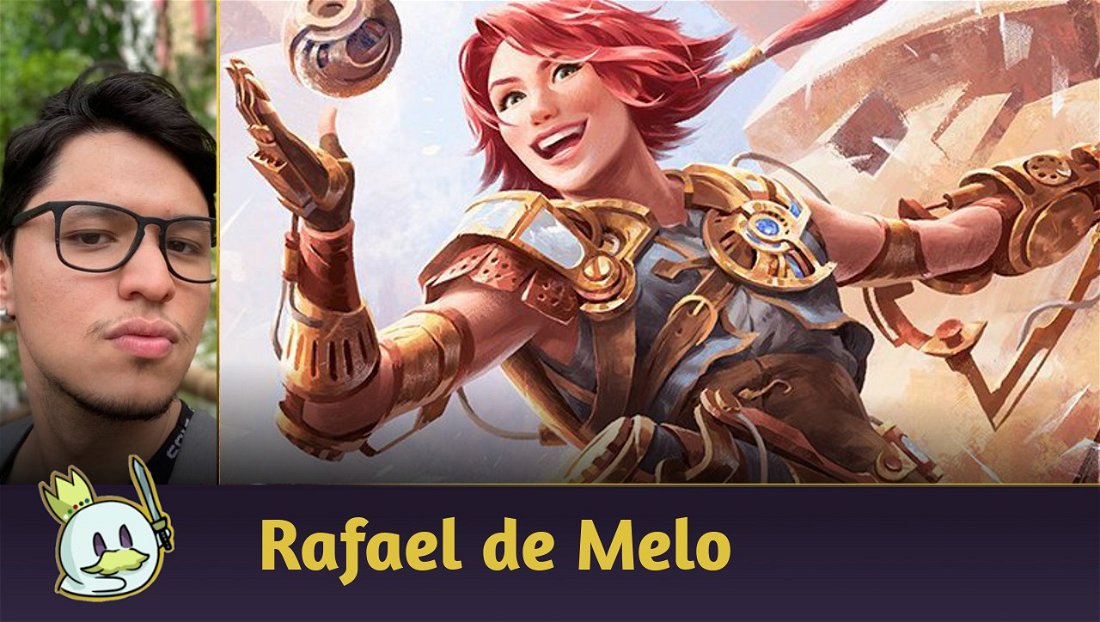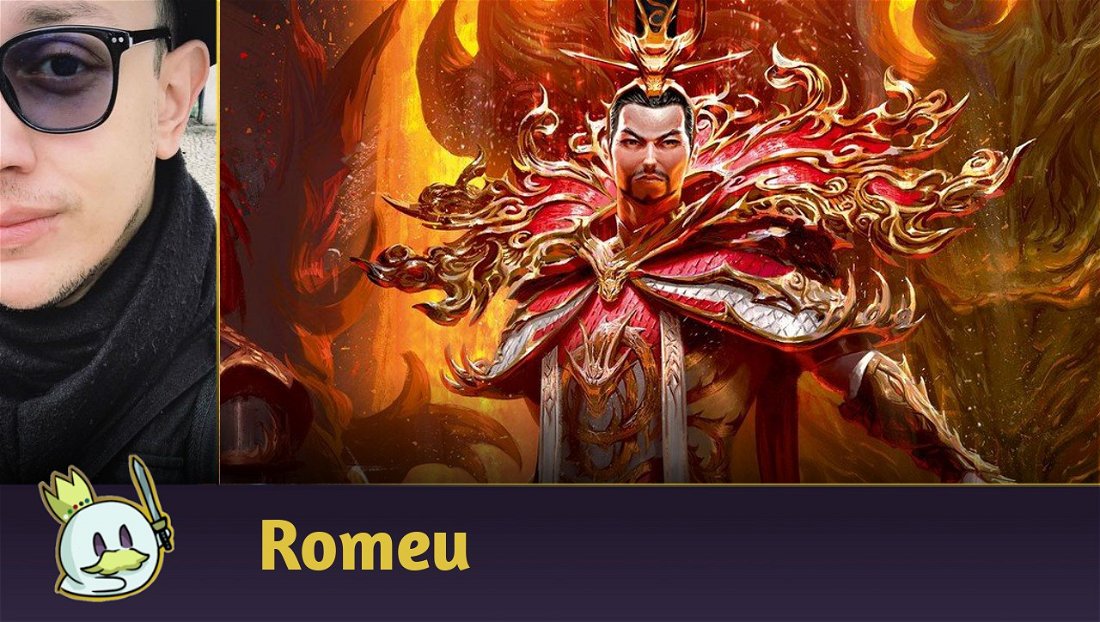Introduction
As a brief story: when I got to know Flesh and Blood I discovered that there were Precons (pre-constructed decks that are generally easier for beginners to get into the game) of some heroes ready to play. After a lot of research, watching videos and reading around the internet, I ended up picking three decks: Levia, Oldhim and Dromai.
When I actually went to pick up the cards, sit at a table and play, the first deck I used was Dromai and, after playing a little, I noticed that it had somewhat different mechanics and that, as far as I knew, the other heroes didn't: she spawned allies who also attacked.
This caught my attention. Reading a little deeper I discovered that these allies can be bigger, that she can alternate between being aggressive or defensive and all of this coupled with a theme focused on dragons and the Chinese Empire. And that's how I had my first Flesh and Blood crush: Dromai, Ash Artist.
Dromai and the Illusionist class

Dromai was introduced in the recent Uprising set as the game's second Illusionist. Despite being the same class, her gameplay differs from Prism. While Monarch
's heroine is more Aura-oriented, Dromai explores a dragon theme where she looks to set them up and make them attack while protecting herself.
Despite the differences, both heroines use attacks characterized by the Phantasm ability, in which if defended by attacks with power six or greater, they are destroyed, lose Go Again (if they have it) and no damage is passed. At first, the ability seems to make the attack super easy to bypass, but there are several decks on Blitz where Phantasm will never be a problem.
At first, it's hard for a beginner to understand what Dromai does, but once understood, it's simple to pick up the dynamic on what this heroine sets out to do.

The first skill means that every time we Pitch a red card (that is, we use a red card to pay a resource) Dromai will create an Ash. Ash is a token that stays on the field (that is, it is not naturally destroyed, you cannot attack it, and you do not lose it at the end of the turn) and its only ability is that anything on it has Phantasm. What this means and what are the implications of this we will talk later.
Her second ability makes your dragons have Go Again while attacking if you played a red card that turn. Sounds good, but so far, I've only mentioned that there is a dragons theme, but what in fact are they and what do they do?
Dragons and Allies mechanics
Dragons are nothing more than Allies used massively in the deck. From the rulebook:
Ally: is a subtype of an object that is an independent attacker/defender during combat, and resets its life at the end of the turn.
In other words, Allies are objects (like items) that are on the field, but they are independent from their own power and life and, because of that, can be attacked by the opponent. Some observations about this mechanic:
If the opponent declares that he is attacking one of your allies or when you attack with them, as they are independent, you cannot use Attack/Defense reactions in this chain link;
- If your Ally's life goes to zero, they leave the field;
- If an Ally's life is not reduced to zero by the end of the turn, but it takes damage, at the end of the turn its life will return to its original value;
- An Ally can only attack if it has the Attack action, as well as weapons have;
- Allies are usually spawned by other cards.
With that in mind, then, let's get down to the actual list to understand how all these concepts come together and visualize how the heroine plays.
The Precon
The list I'm going to start talking about is the Precon list from Dromai. So if you go to your local store right now and buy that product, those are the cards on them. Despite being far from competitive, plenty of people got into the game through her, so it's interesting to look at its strategy and see how to turn it into something really competitive.
Before talking about the list itself, note that many cards say “(...) transform an Ash into Aether Ashwing (...)”. What does that mean?

When we transform an Ash, it means that now this token has, on top of it, an Ally specified in the card that transformed it, which, in the case of Precon, is Aether Ashwing(a small dragon that has Arcane barrier 1). In practice, one Ash of yours is now a dragon, however it has Phantasm (since it was transformed from token) and does not attack naturally (because it doesn't have the ability to Attack), so how are we going to attack with our dragons? The answer is in our weapon.

Despite not attacking, Storm of Sandikai is what grants your dragons the ability to attack at zero cost, and to pace the attacks, Dromai grants the dragons Go Again - allowing attacks by a horde of dragons. And it is on this line that our heroine plays.
In addition, some other points draw our attention when we look at the list as a whole, one of them is that almost 100% of the deck is composed of red cards. This makes sense when we want to extract Dromai's ability as much as possible. It's terrible to want to spawn our dragons without having an Ash for that, so we need to have as many Ashes as possible.
Another point is that the deck seems to want to be aggressive and defensive at times - and in fact it is. The deck can't be as aggressive as Fai, but it also can't be as defensive as Oldhim. So, what's the advantage of playing along those lines?
Dromai's charm lies in understanding how to spend your cards to generate resources and how to get the most value out of your turn. The precon is simpler in this regard, but it presents the idea of the heroine well: protect yourself and win with a horde of dragons.
The precon list doesn't have Majestics, Legendaries and very few Rares cards, but it fulfills the role of being simple, playable and didactic very well for those who are starting in the game.
The Strategy
Whatever the list, the objective will always be the same: to generate several dragons, and use them to attack while defending with the cards in your hand. If your opponent decides to kill the dragons, we can use cheap (but strong) attacks to establish pressure. Otherwise, you can protect yourself and hold the pressure while filling the board with dragons - forcing the opponent to defend themselves or kill them all at once.
Several cards on this list can be used for future versions of the deck, showing how this Precon is well-constructed and has a good upgrade base, so let's start talking about them.
Except for a few cards, all those that will be mentioned are used in their red versions to synergize with the heroine's ability:

Billowing Mirage (1) when attacking generates an Aether Ashwing, has power three and Go Again. The great thing about this type of card on the list is that, in practice, the card offers a power of four exchange (three of itself plus one of the generated dragon), and with Go Again we can play it and already hit the dragon also with go again thanks to Dromai.
Rake the Embers (1) is the strongest Aether Ashwing generator in the deck. It doesn't have a complex setup to take advantage of it and since it spawns an Ash on its own, you will always have at least one dragon. If you Pitched a red card to make this action card, two dragons will be spawned. It's an excellent card to leave in the arsenal in the first turns and then play it with the established setup.
Another dragon spawner used in the list is Skittering Sands (1). Despite only transforming one Ash, it gives the token three more power until the end of the turn, allowing an attack for four. It's not a very used card in more competitive formats, but in Commoner it's mandatory on any list.

Embermaw Cenipai (1) and Dunebreaker Cenipai (1) are the deck's Ash generators without the need to use Dromai. These attacks are excellent in situations in which we need to build a setup, especially in the first turns, without giving up a threat.
Dustup (1) is a nice turn finisher with an On-Hit effect that turns an Ash into an Aether Ashwing. Despite not having Go Again, it is a great attack to spawn another dragon in exchange for zero resources.
Ravenous Rabble (1) may seem weak because it gains less power when it attacks, but since the deck is almost entirely made of red cards, it will be the attack with four power with Go Again for zero resources. In addition to being a great aggressor, it's interesting to start the "combat chain" with it to pace the next attacks with the dragons.
And, to top off these excellent cards, Spears of Surreality (1) is a cheap attack, with generous power and still offers Go Again. Despite having Phantasm, it helps at establishing pressure on the opponent.
Equipment
Since its pretty basic, we will not delve into the equipment so much, but some will be ran until the final list.
As mentioned, Storm of Sandikai is the weapon that gives your dragons the ability to attack, so we won't consider any other weapon, and it is used in all formats where Dromai plays (from Commoner to Classic Constructed).

Ironhide Helm and Ironhide Legs fulfill the same purpose of having more defense, especially against decks that hit very hard or with multiple attacks. We can even keep them as a sideboard for future lists, but the tendency is to leave them aside as the level goes up.
Silken Form is good enough on its own. In addition to its Quell 1 ability that can be paid multiple times during the turn (generating more Ash consequently), before being destroyed, you can use its instant ability to generate one more Aether Ashwing to extract the most out of it. Let's use this equipment in our hands for the next lists.
Deep Blue has the function of turning any card in your hand into a blue Pitch. It is a very interesting option, mainly due to our lack of generating resources with a mainly red deck, and it should be used as a low-budget option.
Precon's problems
Despite being very well constructed, the list is not without problems and should be considered when changing the list. They are:
- Some cards are lost in the list and do not comply with its strategy;
- The equipment is reasonable, but there are better ones;
- Despite generating Aether Ashwing, the deck does not have cards that generate the greater dragons, making the list much more fragile and slower.
So, for the first upgrade, we're going to alleviate these problems as much as possible without adding extremely expensive cards.
First Upgrade
The Dragon Package
The first and highest priority thing to do to improve the deck is to include the larger dragons. Dromai has a range of dragon options and I recommend getting them all (especially if there is a plan to build this deck in Classic Constructed), but there is a priority on which ones to get. They are: Invoke Azvolai, Invoke Cromai, Invoke Kyloria and Invoke Miragai.
Azvolai is almost a Rosetta Thorn, with the difference that the two arcane damage must be distributed on two different targets. It does not seem so good, but in a mirror match, an attack from this dragon allows you to manage to kill two Aether Ashwing, but usually, one of arcane damage will go to your opponent.
Cromai gives you one action point when it attacks or leaves the battlefield (either by Phantasm's effect or when destroyed by the opponent). Gaining this action point allows you to increase your attack cadence, even if some of them don't have Go Again, but the dragon turns out to be strong when it dies from the Phantasm, since it leaves an action point and you can continue the attacks with your other dragons or make more action cards in the turn.
In addition to having an excellent power, Kyloria, with its On-Hit effect, will usually give you an extra card per turn - which is already good on its own, but the ability to steal an item from an opponent can present an imminent threat to Dash or Kano, who need to establish setups with these items.
Miragai removes the Phantasm effect from the first dragon it attacks (important to note it's from the first dragon, not the first draconic attack). With it on the field, a good strategy is to attack with your strongest dragon or the one most threatening to the opponent, as it is guaranteed that your combat chain will not end with this attack.
The list also allows you to use other dragons, but these are more up to personal tastes. Dominia to remove cards from the opponent's hand, Ouvia to fill the board with Aether Ashwing, Yendurai as a harder dragon to kill, Nekria to hit well and generate more Ash tokens and so on. In this slot, I'll use Invoke Yendurai because it only costs one resource and is more resilient, but any other option should be good enough.
The only dragon I don't recommend using in Blitz is Themai because it doesn't have as wide a use as the others. However, if you play in a Metagame with plenty of Wizards, it seems like a reasonable choice.
To fit all these dragons, we will remove from the list all copies of Brutal Assault (1), Critical Strike (1), Wounding Blow (1) (these cards aren't good), Lava Burst (because of the setup needed to get its maximum value) and Red Hot (which is better in Classic Constructed as games tends to go longer).

Defensive Package
If we look at the original list, it has an excellent defensive set. Setting up a Precon with Sink Below (1), Oasis Respite (1) and Sigil of Solace (1) was a great hit by LSS and should definitely be kept on the deck. The only defensive card we'll trade will be Healing Balm (1) because it's an Action, which means it requires an Action Point to play. In its place will be placed Sand Cover (1) which is an Instant, costs zero resources and makes your Ash prevent four damage. Despite the token being destroyed, the deck allows you to replace it easily, so this shouldn't be a problem.

Other Cards
We still need to change some cards and put better ones that match the strategy and help the dragons. Here we go a little against the norm and add some blue cards because they are good for Illusionist attacks (keep in mind that dragons are also the Illusionist type). They are: Passing Mirage and Pierce Reality. While Passing Mirage strips Phantasm from the first Illusionist attack, Pierce Reality grants two more power to the first Illusionist attack of the turn (identical to what Teklo Pounder does). These auras are mainly here to improve the stats of our dragons, but they also improve other cards like Spears of Surreality (1) and Embermaw Cenipai (1).
To include two Passing Mirage and one Pierce Reality, let's take the two copies of Sweeping Blow (3) (since we're already managing to generate Ash quite consistently) and one Skittering Sands (1) (as we are no longer focusing on generating Aether Ashwing).

We're also going to take the other copy of Skittering Sands (1) and the other Sweeping Blow (1) to put one Uprising and two Burn Them All. Both have the same goal of being aggressive and granting additional damage in the mid/late game and help our dragons be more threatening.

Last, but not least, let's remove the two Enigma Chimera (1) to put Miraging Metamorph because the Majestic costs one less resource and only hits one less than Enigma. Its ability is not as relevant, but it can copy a Burn Them All to guarantee even more damage if it occurs.

Regarding equipment, we can, without spending too much, add a few more that are important, but are not in the Precon.

Although the deck manages to generate several Aether Ashwing, it is important to have equipment that also has Arcane Barrier. On the head we use Crown of Reflection, as it has the Illusionist type and, perhaps, and we can eventually use its activated abiity.
On its feet, Silent Stilettos also has Arcane Barrier and its ability allows you to recover an action point when any of your Phantasm attacks are destroyed, but it is in that slot exclusively for Arcane Barrier. To finish the set, we have Nullrune Gloves for the same purpose, completing three Arcane Barrier equipments.
Note that all equipment has Arcane Barrier 1. This is important since we mostly run red cards.
In the end, we will have the following decklist:
The Competitive List
Although the previous list has a very solid core and is a beautiful portrait of what Dromai is all about in Blitz, it still lacks the best that the game has to offer. The main lack of the previous list is defense with equipment, so we are going to change a few more cards and turn it into a competitive list and with the best technologies available for the deck.
For the final decklist, I used the Dromai that took first place in a Skirmish (a tournament with a slightly higher competitive level) piloted by Wojeich Arendt, with only a few equipment changes:
In the main deck, the change will only be four cards: we will take all the blue cards (two Passing Mirage and Pierce Reality) and one Uprising to add two Command and Conquer and two Erase Face.

Command and Conquer needs no introduction. It's one of the best generic attacks in the game and very desirable for any deck that wants to go aggressive. Erase Face is slightly less popular, but its On-Hit effect can be a nightmare for decks like Dash and Fai that rely heavily on card types.
Now the most notable changes are in equipment. Dromai demands a lot of legendary equipment, but a must for her strategy is Flamescale Furnace. In addition to defending three damage with Temper's ability, it allows you to turn one resource into up to four (as long as you have all these cards in the Pitch zone). This equipment is extremely essential and necessary for the deck since we lack resource generation. Without this armor, it would not be possible, for example, to make bigger dragons with higher costs only with red cards.
Phantasmal Footsteps is already known to Prism players, and here it will have the same role. The equipment does everything the deck needs: it gives an action point if an attack with Phantasm is destroyed, and defends one. Note that you can always defend without the equipment breaking (as long as you don't block attacks with power greater than or equal to six), and paying the necessary resource with a red card (which will happen), will be generating an Ash as well.
In the head, Crown of Providence defends two and allows us to fix our hand or protect our arsenal from cards like Breaking Point and Command and Conquer. The crown already proves to be an excellent option for any deck that does not have equipment that is specific to strategy or class.

Finally, we will have the following final competitive list. If you don't like the idea of all the cards being red, it's also a suitable option to take the previous list and add the legendary equipment, which will result in a list that is just as good.
Tips & Tricks
Some tips and things to look out for when playing with the list:
- When a dragon dies, the Ash that was under it also ceases to exist, so there is a concern to always generate the token;
- The physical cards that make dragons (the ones that usually start with “Invoke”) have, on their back, the dragon they represent (For example, Invoke Cromai has Cromai on their back). So, always use sleeves to play or representative cards;
- "Invoke" cards resolve like dragons, so they don't go to the graveyard, but are transformed into their respective dragon allies. Invoke Yendurai, for example, will enter the field transformed into Yendurai, and not generate a token named Yendurai.
- It is necessary to play a red card to grant Go Again to the dragons, but it is still possible to attack with only one dragon and pass the turn;
- If any attack is destroyed due to Phantasm's ability, it loses Go Again - including your dragons;
- Any resource paid by a red Pitch generates an Ash, either to make cards from your hand, pay additional costs that an Iyslander can impose on you or equipment abilities.
Dromai's Pros and Cons
Dromai is a strong hero because she can defend herself well and have several attacks that don't necessarily come from her hand, so the longer the game goes on, the more dragons are on the field and the stronger her future combat chains will be. Furthermore, dragons pose a dilemma to the opponent: attack you or them?
One problem, however, is Blitz's fast-paced and explosive nature, which can provide an initial pressure to the heroine that she may not be able to handle. That's why it's important to always have an excellent defensive package, both in cards and equipment, to gain time to establish an attack setup.
Matchups
Some matchups that require some specific care:
- Against any deck with attacks that destroy your dragons easily (Guardians, Prism and Brutes), seek to play key dragons like Cromai and Miragai and give more focus to attacks that don't get destroyed like Ravenous Rabble (1) and Dustup (1). Don't make the mistake of starting the combat chain with your biggest threat, and always try to get around the blocks that destroy cards with Phantasm;
- Against decks with plenty of small attacks, watch your opponent's playing posture. If they focus on your dragons, try to use the other attacks to establish pressure, otherwise, defend well until you have so many dragons that your opponent has to start blocking them.
Conclusion
Dromai is one of the coolest decks to play because it has a different mechanic than the others. Although it is simple to understand how the deck works, the real difficulty is in understanding the small interactions between its cards and how your opponent can nullify your strategy, and that is why it is a deck that demands time and dedication and rewards those who are most dedicated to it.
Thank you for reading this far, and until next time!















— commentaires 0
, Réactions 1
Soyez le premier à commenter